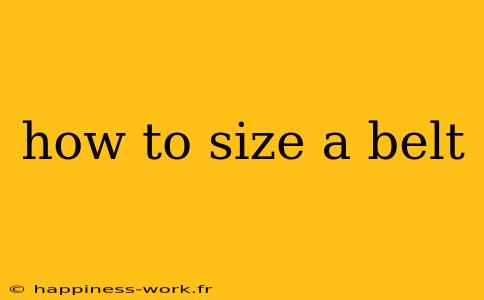When it comes to fashion accessories, a well-fitted belt can elevate your outfit and provide comfort. However, sizing a belt correctly can be tricky. In this article, we will delve into the various methods of sizing a belt, providing you with practical examples, tips, and additional insights. We will also reference some effective techniques from WikiHow, ensuring the guidance you receive is both reliable and comprehensive.
Step-by-Step Guide to Sizing a Belt
1. Measure Your Waist
How to Measure:
- Use a Measuring Tape: Take a flexible measuring tape and wrap it around your waist where you typically wear your belt. Ensure it is snug but not too tight.
- Take Note of the Measurement: Record the measurement in inches.
Analysis:
The measurement you take should be as accurate as possible. If you don't have a measuring tape, you can use a piece of string or ribbon and then measure it against a ruler or yardstick.
2. Calculate Your Belt Size
Typical Formula: To find your belt size, add 2 inches to your waist measurement. For example, if your waist measures 32 inches, then a belt of 34 inches is appropriate.
Practical Example:
- Waist Measurement: 36 inches
- Belt Size: 36 + 2 = 38 inches
3. Consider the Style of the Belt
Different Types of Belts:
- Casual Belts: Usually sized to your waist measurement plus 2 inches.
- Dress Belts: Often sized to fit exactly at your waist measurement.
- Specialty Belts: Like those designed for specific jobs or functions (e.g., tool belts), may have different sizing standards.
Additional Explanation:
The style of the belt impacts how it fits. For example, a leather dress belt may be made with stiffer material and may not stretch like a casual canvas belt. Always consider the style when determining your size.
4. Try Before You Buy
Why It's Important:
Whenever possible, try on belts before purchasing. Different brands can vary in sizing, and a size that works for one may not work for another.
Attribution:
As per WikiHow, “If you’re shopping online, look for a brand that offers free returns so you can swap sizes if necessary.” This is a crucial tip, as it gives you flexibility without risking loss.
5. Adjusting for Fit
Finding the Right Fit:
- Belts often come with several sizing holes. Ideally, the belt should fit comfortably on the middle hole. This allows for adjustments if needed.
- Analyzing Fit: If the belt is too loose or tight even on the correct hole, consider getting a different size or a belt with a different adjustment mechanism.
Example of Adjustment:
If your belt has five holes and you’re using the second or fourth hole, then it might be worth considering a belt that better suits your size.
6. Alternative Sizing Methods
Belt Sizes by Length: Some brands list their belts in sizes like S, M, L, or numerical sizes. Here’s how to correlate them:
- Small: 28-30 inches
- Medium: 32-34 inches
- Large: 36-38 inches
- Extra Large: 40-42 inches
Attribution:
According to WikiHow, “You can also refer to a size chart from the brand’s website to ensure that you select the right size for your needs.”
Conclusion
Finding the right belt size is essential for both style and comfort. Whether you're measuring your waist, taking into account different styles of belts, or utilizing size charts, the key is accuracy. By following the steps outlined in this article, and applying insights from sources like WikiHow, you can ensure you choose the perfect belt size for your wardrobe.
Final Tip
Always keep your personal preference in mind. Some may prefer a tighter or looser fit based on comfort or style. As trends change, so too may your preferred belt size. Regularly reassess your options as part of your wardrobe management.
By taking these additional insights and tips into account, you'll not only choose the right size but also find a belt that reflects your personal style. Happy shopping!
